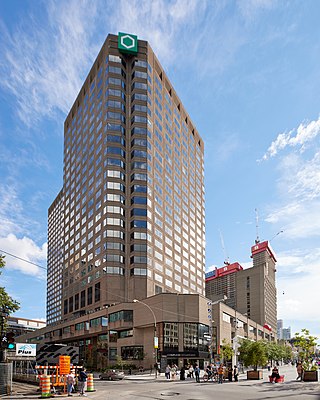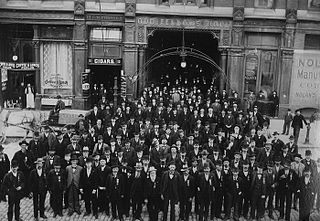
Cambridge is a city in the Regional Municipality of Waterloo, Ontario, Canada, located at the confluence of the Grand and Speed rivers. The city had a population of 138,479 as of the 2021 census. Along with Kitchener and Waterloo, Cambridge is one of the three core cities of Canada's tenth-largest metropolitan area.

The County of Brant is a single-tier municipality in the Canadian province of Ontario. Although it retains the word "county" in its name, the municipality is a single-tier municipal government and has no upper tier. The County of Brant has service offices in Burford, Paris, Oakland, Onondaga and St. George. The largest population centre is Paris.
The Independent Order of Foresters, operating as Foresters Financial, is a fraternal benefit society headquartered in Toronto, Ontario, Canada that provides life insurance and other financial solutions in Canada, the United Kingdom, and the United States. As of 2022, Louis Gagnon has served as the company’s President and CEO.

The Desjardins Group is a Canadian financial service cooperative and the largest federation of credit unions in North America. It was founded in 1900 in Lévis, Quebec by Alphonse Desjardins. While its legal headquarters remains in Lévis, most of the executive management, including the CEO, is based in Montreal.

Sun Life Financial Inc. is a Canadian financial services company. It is primarily known as a life insurance company.
The David Suzuki Foundation is a science-based non-profit environmental organization headquartered in Vancouver, British Columbia, Canada, with offices in Montreal and Toronto. It was established as a federally registered Canadian charity on January 1, 1991. By 2007, it had 40,000 donors. Its mission is to protect nature while balancing human needs. It is supported entirely by Foundation grants and donations and by 2012, 90% of its donors were Canadian. By 2007, the Foundation employed about seventy-five staff members.
Galt is a community in Cambridge, Ontario, Canada, in the Regional Municipality of Waterloo, Ontario on the Grand River. Prior to 1973, it was an independent city, incorporated in 1915, but amalgamation with the town of Hespeler, Ontario, the town of Preston, Ontario and the village of Blair formed the new municipality of Cambridge. Today it is also known as Downtown Cambridge. The first mayor of Cambridge was Claudette Millar.

Manulife Financial Corporation is a Canadian multinational insurance company and financial services provider headquartered in Toronto, Ontario. The company operates in Canada and Asia as "Manulife" and in the United States primarily through its John Hancock Financial division. As of December 2021, the company employed approximately 38,000 people and had 119,000 agents under contract, and has CA$1.4 trillion in assets under management and administration. Manulife at one point serviced over 26 million customers worldwide.

The Canada Life Assurance Company, commonly known as Canada Life, is an insurance and financial services company with its headquarters in Winnipeg, Manitoba. The current company is the result of the 2020 amalgamation of The Great-West Life Assurance Company, London Life Insurance Company and The Canada Life Assurance Company, along with their holding companies. The company is a wholly owned subsidiary of Great-West Lifeco.
Waterford is one of the Communities in Norfolk County, Ontario and had a population of 3,132 at the time of the 2016 Census.
Joseph Emm Seagram was a Canadian distillery founder, politician, philanthropist, and major owner of thoroughbred racehorses.

Wawanesa Insurance—officially The Wawanesa Mutual Insurance Company, also known as Wawanesa Mutual or simply Wawanesa —is a Canadian mutual insurance firm, as well as among Canada's ten largest property and casualty insurers.

NFU Mutual is a UK insurance composite. It is a mutual, therefore, its policyholder members own the business, and the executives and directors are ultimately accountable to them. The full name of the organisation is National Farmers' Union Mutual Insurance Society Limited.

Kin Canada is a secular Canadian non-profit service organization that promotes service, fellowship, positive values, and national pride.

The Ancient Order of United Workmen (AOUW) was a fraternal organization in the United States and Canada, providing mutual social and financial support after the American Civil War. It was the first of the "fraternal benefit societies", organizations that would offer insurance as well as sickness, accident, death and burial policies.

The Bell Memorial is a memorial designed by Walter Seymour Allward to commemorate the invention of the telephone by Alexander Graham Bell at the Bell Homestead National Historic Site, in Brantford, Ontario, Canada.

Pioneers, a Volunteer Network, founded and more commonly known as the Telephone Pioneers of America, is a non-profit charitable organization based in Denver, Colorado in the United States. The association was organized in Boston in November 1911 by 246 pioneers active in the early days of telephony, including Alexander Graham Bell who received membership card No. 1. The first elected president was Theodore N. Vail, president of the American Telephone and Telegraph Company (AT&T).
Donald McQueen Shaver was a Canadian pioneer in the poultry industry, who founded a breeding company that achieved worldwide prominence. At its peak Shaver Poultry Breeding Farms was the world's largest, being one of only two "world class foundation breeding" companies in Canada. Shaver died in 2018 of age related causes.

Sentry Insurance is a mutual insurance company specializing in business insurance. The company’s home office is in Stevens Point, Wisconsin, where about half the company’s approximately 4,500 employees are located. Sentry offers property and casualty insurance, workers' compensation, life insurance, and other business insurance, as well as non-insurance products like annuities and retirement programs. Sentry provides specialized insurance programs to customers in specific industries as well as very large companies with complex risk.

The Lake Erie and Northern Railway was an interurban electric railway which operated in the Grand River Valley in Ontario, Canada. The railway owned and operated a north–south mainline which ran from Galt in the north to Port Dover on the shore of Lake Erie in the south. Along the way, it ran through rural areas of Waterloo County, Brant County, and Norfolk County, as well as the city of Brantford, where it had an interchange with the Brantford and Hamilton Electric Railway. Construction on the mainline began in 1913. The railway began operations in 1916 as a subsidiary of the Canadian Pacific Railway (CPR), which had purchased the line before construction had finished. In 1931, it was consolidated with the Grand River Railway under a single CPR subsidiary, the Canadian Pacific Electric Lines (CPEL), which managed both interurban railways, though they continued to exist as legally separate entities. Passenger service was discontinued in 1955 but electric freight operations continued until 1961, when the LE&N's electric locomotives were replaced by diesel CPR locomotives and the line was de-electrified. In the same year, service on the mainline from Simcoe to Port Dover was discontinued, but the remainder continued to operate as a branchline which as early as 1975 was known as the CP Simcoe Subdivision. The remainder of the line was officially abandoned in the early 1990s, ending almost seventy-five years of operation.














